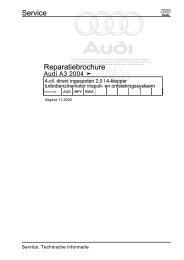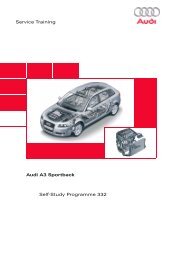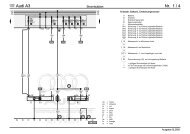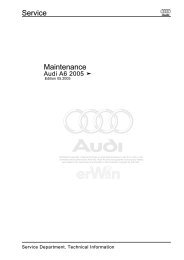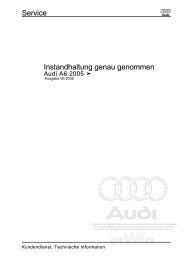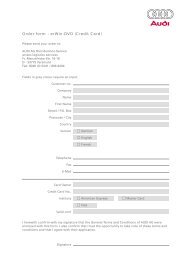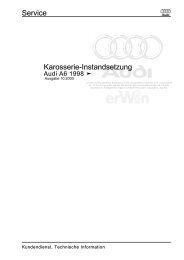Audi A3 2004 Direct petrol injection and ignition system
Audi A3 2004 Direct petrol injection and ignition system
Audi A3 2004 Direct petrol injection and ignition system
Create successful ePaper yourself
Turn your PDF publications into a flip-book with our unique Google optimized e-Paper software.
ServiceWorkshop Manual<strong>Audi</strong> <strong>A3</strong> <strong>2004</strong> ➤<strong>Direct</strong> <strong>petrol</strong> <strong>injection</strong> <strong>and</strong> <strong>ignition</strong> <strong>system</strong> (4-cyl. 2.0 ltr.4-valve turbo)Engine ID AXX BPY BWAEdition 11.2005Protected by copyright. Copying for private or commercial purposes, in part or in whole, is notpermitted unless authorised by AUDI AG. AUDI AG does not guarantee or accept any liabilitywith respect to the correctness of information in this document. Copyright by AUDI AG.Service Department. Technical Information
ServiceList of Workshop Manual Repair GroupsRepair Group24 - Mixture preparation - <strong>injection</strong>28 - Ignition <strong>system</strong>Protected by copyright. Copying for private or commercial purposes, in part or in whole, is notpermitted unless authorised by AUDI AG. AUDI AG does not guarantee or accept any liabilitywith respect to the correctness of information in this document. Copyright by AUDI AG.Technical information should always be available to the foremen <strong>and</strong> mechanics, because theircareful <strong>and</strong> constant adherence to the instructions is essential to ensure vehicle road-worthiness <strong>and</strong>safety. In addition, the normal basic safety precautions for working on motor vehicles must, as amatter of course, be observed.All rights reserved.No reproduction without prior agreement from publisher.Copyright © 2005 <strong>Audi</strong> AG, IngolstadtA0050442920
<strong>Audi</strong> <strong>A3</strong> <strong>2004</strong> ➤<strong>Direct</strong> <strong>petrol</strong> <strong>injection</strong> <strong>and</strong> <strong>ignition</strong> <strong>system</strong> (4-cyl. 2.0 ltr. 4-valve turbo) - Edition 11.2005Contents24 - Mixture preparation - <strong>injection</strong> . . . . . . . . . . . . . . . . . . . . . . . . . . . . . . . . . . . . . . . . 11 Servicing <strong>injection</strong> <strong>system</strong> . . . . . . . . . . . . . . . . . . . . . . . . . . . . . . . . . . . . . . . . . . . . . . . . . . 11.1 General notes on self-diagnosis . . . . . . . . . . . . . . . . . . . . . . . . . . . . . . . . . . . . . . . . . . . . . . 11.2 Safety precautions . . . . . . . . . . . . . . . . . . . . . . . . . . . . . . . . . . . . . . . . . . . . . . . . . . . . . . . . 11.3 Rules for cleanliness . . . . . . . . . . . . . . . . . . . . . . . . . . . . . . . . . . . . . . . . . . . . . . . . . . . . . . 21.4 Procedure to be followed prior to opening high-pressure <strong>injection</strong> <strong>system</strong> - take note of thefollowing: . . . . . . . . . . . . . . . . . . . . . . . . . . . . . . . . . . . . . . . . . . . . . . . . . . . . . . . . . . . . . . 31.5 Technical data . . . . . . . . . . . . . . . . . . . . . . . . . . . . . . . . . . . . . . . . . . . . . . . . . . . . . . . . . . 41.6 Overview - fitting locations . . . . . . . . . . . . . . . . . . . . . . . . . . . . . . . . . . . . . . . . . . . . . . . . . . 51.7 Exploded view - intake manifold . . . . . . . . . . . . . . . . . . . . . . . . . . . . . . . . . . . . . . . . . . . . . . 131.8 Exploded view - fuel rail . . . . . . . . . . . . . . . . . . . . . . . . . . . . . . . . . . . . . . . . . . . . . . . . . . . . 151.9 Exploded view - air cleaner / engine cover panel . . . . . . . . . . . . . . . . . . . . . . . . . . . . . . . . 161.10 Removing <strong>and</strong> installing engine cover panel with air filter element . . . . . . . . . . . . . . . . . . 161.11 Removing <strong>and</strong> installing intake manifold with fuel rail . . . . . . . . . . . . . . . . . . . . . . . . . . . . 181.12 Removing <strong>and</strong> installing injectors . . . . . . . . . . . . . . . . . . . . . . . . . . . . . . . . . . . . . . . . . . . . 221.13 Checking initial fuel pressure (up to high-pressure pump) . . . . . . . . . . . . . . . . . . . . . . . . . . 261.14 Checking fuel pressure <strong>and</strong> residual pressure (up to high-pressure pump) . . . . . . . . . . . . 281.15 Exploded view - high-pressure fuel pump . . . . . . . . . . . . . . . . . . . . . . . . . . . . . . . . . . . . . . 311.16 Removing <strong>and</strong> installing high-pressure fuel pump . . . . . . . . . . . . . . . . . . . . . . . . . . . . . . . . 321.17 Wiring <strong>and</strong> component check with test box V.A.G 1598/42 . . . . . . . . . . . . . . . . . . . . . . . . 341.18 Renewing Motronic control unit J220 . . . . . . . . . . . . . . . . . . . . . . . . . . . . . . . . . . . . . . . . 361.19 Removing <strong>and</strong> installing Lambda probe G39 <strong>and</strong> Lambda probe heater Z19 before catalyticconverter . . . . . . . . . . . . . . . . . . . . . . . . . . . . . . . . . . . . . . . . . . . . . . . . . . . . . . . . . . . . . . 391.20 Removing <strong>and</strong> installing Lambda probe after catalytic converter G130 <strong>and</strong> Lambda probe 1heater, after catalytic converter Z29 . . . . . . . . . . . . . . . . . . . . . . . . . . . . . . . . . . . . . . . . . . 3928 - Ignition <strong>system</strong> . . . . . . . . . . . . . . . . . . . . . . . . . . . . . . . . . . . . . . . . . . . . . . . . . . . . 411 Checking <strong>ignition</strong> <strong>system</strong> . . . . . . . . . . . . . . . . . . . . . . . . . . . . . . . . . . . . . . . . . . . . . . . . . . 411.1 General notes on <strong>ignition</strong> <strong>system</strong> . . . . . . . . . . . . . . . . . . . . . . . . . . . . . . . . . . . . . . . . . . . . 411.2 Safety precautions . . . . . . . . . . . . . . . . . . . . . . . . . . . . . . . . . . . . . . . . . . . . . . . . . . . . . . . . 411.3 Technical data for <strong>ignition</strong> <strong>system</strong> . . . . . . . . . . . . . . . . . . . . . . . . . . . . . . . . . . . . . . . . . . . . 41Protected by copyright. Copying for private or commercial purposes, in part or in whole, is notpermitted unless authorised by AUDI AG. AUDI AG does not guarantee or accept any liabilitywith respect to the correctness of information in this document. Copyright by AUDI AG.2 Ignition <strong>system</strong> - exploded view of components . . . . . . . . . . . . . . . . . . . . . . . . . . . . . . . . . . 423 Removing <strong>and</strong> installing <strong>ignition</strong> coils with output stages . . . . . . . . . . . . . . . . . . . . . . . . . . 43Contentsi
<strong>Audi</strong> <strong>A3</strong> <strong>2004</strong> ➤<strong>Direct</strong> <strong>petrol</strong> <strong>injection</strong> <strong>and</strong> <strong>ignition</strong> <strong>system</strong> (4-cyl. 2.0 ltr. 4-valve turbo) - Edition 11.2005Protected by copyright. Copying for private or commercial purposes, in part or in whole, is notpermitted unless authorised by AUDI AG. AUDI AG does not guarantee or accept any liabilitywith respect to the correctness of information in this document. Copyright by AUDI AG.iiContents
<strong>Audi</strong> <strong>A3</strong> <strong>2004</strong> ➤<strong>Direct</strong> <strong>petrol</strong> <strong>injection</strong> <strong>and</strong> <strong>ignition</strong> <strong>system</strong> (4-cyl. 2.0 ltr. 4-valve turbo) - Edition 11.200524 – Mixture preparation - <strong>injection</strong>1 Servicing <strong>injection</strong> <strong>system</strong>1.1 General notes on self-diagnosis♦ The engine control unit has a self-diagnosis capability. Beforecarrying out repairs <strong>and</strong> fault finding the fault memory must beinterrogated. The vacuum hoses <strong>and</strong> connections must alsobe checked (unmetered air).♦ Fuel hoses in engine compartment must only be secured withspring-type clips. Clamping-type or screw-type clips must notbe used.♦ A voltage of at least 11.5 V is required for proper operation ofthe electrical components.♦ Do not use sealants containing silicone. Particles of siliconedrawn into the engine will not be burnt in the engine <strong>and</strong> willdamage the Lambda probe.♦ The vehicles are fitted with a crash/fuel shut-off <strong>system</strong>. This<strong>system</strong> is designed to reduce the risk of a vehicle fire after acrash by deactivating the fuel pump via the fuel pump relay.♦ At the same time, this <strong>system</strong> also improves the engine's start‐Protected by copyright. Copying for private or commercial purposes, in part or in whole, is notpermitted unless authorised by AUDI AG. AUDI AG does not guarantee or accept any liabilityingwith respectperformance.to the correctnessWhenof informationthe driver'sin this document.door isCopyrightopened,by AUDItheAG.fuelpump is activated for 2 seconds in order to build up pressurein the fuel <strong>system</strong> → Chapter (page 1).1.2 Safety precautionsWARNINGThe fuel <strong>system</strong> is pressurised. The fuel pressure in the highpressurepart of the <strong>injection</strong> <strong>system</strong> must be reduced to aresidual pressure prior to opening; for procedure see→ Chapter (page 3).The connection must be opened IMMEDIATELY after reducingthe pressure by wrapping a cloth around the connection<strong>and</strong> allowing the residual pressure (approx. 6 bar) to dissipate.Note the following if testers <strong>and</strong> measuring instruments have tobe used during a road test:WARNING♦ Test equipment must always be secured on the rear seat<strong>and</strong> operated from that position by a second person.♦ If test <strong>and</strong> measuring instruments are operated from frontpassenger's seat <strong>and</strong> the vehicle is involved in an accident,the person sitting in this seat could be seriouslyinjured when the airbag is triggered.1. Servicing <strong>injection</strong> <strong>system</strong> 1
<strong>Audi</strong> <strong>A3</strong> <strong>2004</strong> ➤<strong>Direct</strong> <strong>petrol</strong> <strong>injection</strong> <strong>and</strong> <strong>ignition</strong> <strong>system</strong> (4-cyl. 2.0 ltr. 4-valve turbo) - Edition 11.2005To avoid any risk of injuries to persons <strong>and</strong>/or damage to the fuel<strong>injection</strong> <strong>and</strong> <strong>ignition</strong> <strong>system</strong>, always observe the following safetyprecautions.♦ If the battery is not disconnected, fuse No. 27 for fuel pumpcontrol unit -J538- must be removed as a precautionary measurebefore opening the fuel <strong>system</strong>, because the fuel pumpwill otherwise be activated by the contact switch on the driver'sdoor.♦ Persons wearing a cardiac pacemaker must at all times maintaina safe distance from high-voltage components such as the<strong>ignition</strong> <strong>system</strong> <strong>and</strong> gas-discharge headlights.♦ Do not open any fuel line connections while the engine is running.♦ Always switch off the <strong>ignition</strong> before connecting or disconnecting<strong>injection</strong> or <strong>ignition</strong> <strong>system</strong> wiring or tester cables.♦ If engine is to be operated at cranking speed without it starting(e.g. compression test), unplug connectors from <strong>ignition</strong> coils<strong>and</strong> remove fuse for electric fuel pump.♦ Certain tests may lead to a fault being detected by the controlunit <strong>and</strong> stored. The fault memory should therefore be interrogated<strong>and</strong> (if necessary) erased after completing the tests<strong>and</strong> any repair work that may be required.♦ If the fault memory has been erased, you must generate thereadiness code again.♦ Always switch off the <strong>ignition</strong> before cleaning the engine.♦ Always switch off the <strong>ignition</strong> before connecting or disconnectingthe battery, otherwise the engine control unit may bedamaged.Protected by copyright. Copying for private or commercial purposes, in part or in whole, is notpermitted unless authorised by AUDI AG. AUDI AG does not guarantee or accept any liabilitywith respect to the correctness of information in this document. Copyright by AUDI AG.♦ If the engine has to be operated at the starting speed withoutactually starting (e.g. to test compression pressure), detachthe four connectors from the <strong>ignition</strong> coils using assembly tool-T40039- → Chapter (page 43). Also remove fuse 27 fromfuel pump control unit -J538- .Note♦ Removing fuse 27 will interrupt the voltage supply for the fuelpump control unit -J538- .1.3 Rules for cleanlinessWhen working on the fuel supply/<strong>injection</strong> <strong>system</strong>, pay careful attentionto the following “6 rules”:♦ Thoroughly clean all unions <strong>and</strong> the adjacent areas beforedisconnecting.♦ Place parts that have been removed on a clean surface <strong>and</strong>cover them over. Do not use fluffy cloths.♦ Carefully cover or seal open components if repairs cannot becarried out immediately.♦ Only install clean components; replacement parts should onlybe unpacked immediately prior to installation. Do not use partsthat have been previously unpacked <strong>and</strong> stored away loose(e.g. in toolboxes, etc.).♦ When the <strong>system</strong> is open: Do not work with compressed air.Do not move vehicle.2 Rep. Gr.24 - Mixture preparation - <strong>injection</strong>
<strong>Audi</strong> <strong>A3</strong> <strong>2004</strong> ➤<strong>Direct</strong> <strong>petrol</strong> <strong>injection</strong> <strong>and</strong> <strong>ignition</strong> <strong>system</strong> (4-cyl. 2.0 ltr. 4-valve turbo) - Edition 11.2005♦ Unplugged electrical connectors; keep them clean <strong>and</strong> dry.Make sure connections are dry when attaching.1.4 Procedure to be followed prior to openinghigh-pressure <strong>injection</strong> <strong>system</strong> - takenote of the following:CautionThe <strong>injection</strong> <strong>system</strong> consists of a high-pressure section(maximum approx. 120 bar) <strong>and</strong> a low-pressure section (approx.6 bar).Prior to opening the high-pressure section (e.g. when removingthe high-pressure pump, fuel rail, injectors, fuel pipesor fuel pressure sender -G247- , the fuel pressure in the highpressuresection must be reduced to a residual pressure ofapprox. 6 bar. The appropriate procedure is described below.Protected by copyright. Copying for private or commercial purposes, in part or in whole, is notpermitted unless authorised by AUDI AG. AUDI AG does not guarantee or accept any liabilitywith respect to the correctness of information in this document. Copyright by AUDI AG.Reducing fuel pressure in high-pressure section– Detach electrical connector at fuel pressure regulating valve -N276- -2- .– Allow engine to idle for about 10 seconds.Note♦ Fuel pressure will be reduced from approx. 50 bar to approx.6 bar when electrical connector is detached from fuel pressureregulating valve -N276- while engine is idling.– Switch off <strong>ignition</strong>.WARNINGThe fuel lines are still filled with fuel, however the fuel is nolonger under high pressure. Wear safety goggles <strong>and</strong> protectiveclothing when opening the fuel <strong>system</strong> to avoid possibleinjury <strong>and</strong> skin contact.Before opening the high-pressure section, wrap a clotharound the connection.– The high-pressure <strong>system</strong> must be opened IMMEDIATELYafter reducing the pressure by wrapping a clean cloth aroundthe connection <strong>and</strong> allowing the residual pressure (approx. 6bar) to dissipate. Any discharged fuel must be collected.– Upon completion of repair work, interrogate fault memory ofengine control unit <strong>and</strong> erase any error entries caused by detachingthe electrical connector.– Generate readiness code in engine control unit in “Guided faultfinding” mode.1. Servicing <strong>injection</strong> <strong>system</strong> 3
<strong>Audi</strong> <strong>A3</strong> <strong>2004</strong> ➤<strong>Direct</strong> <strong>petrol</strong> <strong>injection</strong> <strong>and</strong> <strong>ignition</strong> <strong>system</strong> (4-cyl. 2.0 ltr. 4-valve turbo) - Edition 11.2005Note♦ You can watch the fuel pressure dropping by connecting a faultreader <strong>and</strong> selecting the engine control unit. Select function“Read measured value block” <strong>and</strong> display group 140.♦ The fuel pressure (actual value) is displayed in zone 3.1.5 Technical dataEngine dataIdling speed is not adjustable; controlledby the idling speed stabilisationSpeed governing by deactivationof fuel injectorsFuel pressureFuel pre-pressure up tohigh-pressure pump (generatedby electric fuel pumpin fuel tank)Fuel high-pressure (generatedby mechanical singleplungerpump) at a coolanttemperature of approx. 85°C.2.0 ltr. / 147 kW turbo FSI engine640 ... 800 rpm6500 rpmapprox. 6.0 bar (identical for all operatingconditions)approx. 49 bar at idling speedapprox. 120 bar in certain parts of operatingrange.Protected by copyright. Copying for private or commercial purposes, in part or in whole, is notpermitted unless authorised by AUDI AG. AUDI AG does not guarantee or accept any liabilitywith respect to the correctness of information in this document. Copyright by AUDI AG.4 Rep. Gr.24 - Mixture preparation - <strong>injection</strong>
<strong>Audi</strong> <strong>A3</strong> <strong>2004</strong> ➤<strong>Direct</strong> <strong>petrol</strong> <strong>injection</strong> <strong>and</strong> <strong>ignition</strong> <strong>system</strong> (4-cyl. 2.0 ltr. 4-valve turbo) - Edition 11.20051.6 Overview - fitting locationsComponents A to Q are not shown in the exploded view.1 - Solenoid valve for chargepressure control -N75-❑ Located directly on turbocharger→ Fig. (page 12)2 - Turbocharger divert airvalve -N249-❑ Located directly on turbocharger→ Fig. (page 12)3 - Motronic control unit -J220-❑ Removing <strong>and</strong> installing→ Chapter (page 36)4 - Ignition coils with outputstages❑ Removing <strong>and</strong> installing→ Chapter (page 43)❑ Ignition coil 1 with outputstage -N70-❑ Ignition coil 2 with outputstage -N127-❑ Ignition coil 3 with outputstage -N291-❑ Ignition coil 4 with outputstage -N292-❑ Puller -T40039- is requiredfor removing <strong>ignition</strong>coils from cylinderhead.5 - Lambda probe -G39- <strong>and</strong>Lambda probe heater -Z19-❑ Removing <strong>and</strong> installing→ Chapter (page 39)6 - Fuel pressure sender for low-pressure section -G410-❑ Tightening torque: 15 Nm7 - Fuel pressure regulating valve -N276-8 - Inlet camshaft timing adjustment valve -1- -N205-Protected by copyright. Copying for private or commercial purposes, in part or in whole, is notpermitted unless authorised by AUDI AG. AUDI AG does not guarantee or accept any liability❑ Removing <strong>and</strong> installing → Rep. Gr. 15with respect to the correctness of information in this document. Copyright by AUDI AG.9 - Coolant temperature sender -G62-❑ → Fig. (page 7)10 - 6-pin connector❑ For Lambda probe -G39- <strong>and</strong> Lambda probe heater -Z19- (black) → Fig. (page 9)11 - Single-plunger high-pressure pump❑ Removing <strong>and</strong> installing → Chapter (page 32)12 - Radiator outlet coolant temperature sender -G83-❑ → Fig. (page 9)1. Servicing <strong>injection</strong> <strong>system</strong> 5
<strong>Audi</strong> <strong>A3</strong> <strong>2004</strong> ➤<strong>Direct</strong> <strong>petrol</strong> <strong>injection</strong> <strong>and</strong> <strong>ignition</strong> <strong>system</strong> (4-cyl. 2.0 ltr. 4-valve turbo) - Edition 11.200513 - Intake manifold flap motor -V157- with intake manifold flap potentiometer -G336-❑ After the fuel rail has been renewed, intake manifold flap potentiometer -G336- must be re-adapted tothe Motronic control unit -J220- → Vehicle diagnosis, testing <strong>and</strong> information <strong>system</strong> VAS 5051; or GuidedFunctions14 - Solenoid valve 1 for activated charcoal filter -N80-15 - Connector❑ For Hall sender -G40- <strong>and</strong> fuel pressure sender -G247-❑ → Fig. (page 11)16 - Charge pressure sender -G31-❑ → Fig. (page 11)17 - Engine speed sender -G28-❑ → Fig. (page 11)18 - 8-pin connector for injectors❑ → Fig. (page 11)19 - Throttle valve module -J338- , throttle valve drive for electric throttle operation -G186-❑ Angle sender 1 for throttle valve drive (electric throttle operation) -G187- <strong>and</strong> angle sender 2 for throttlevalve drive (electric throttle operation) -G188-❑ After the throttle valve module -J338- has been renewed, it must be re-adapted to the Motronic controlunit -J220- (Basic setting, Display group 60), see → Vehicle diagnosis, testing <strong>and</strong> information <strong>system</strong>VAS 5051; or Guided Functions20 - Intake air temperature sender -G42-21 - Fuel pressure sender -G247-❑ Tightening torque: 22 Nm❑ → Fig. (page 8)22 - Hall sender -G40- (camshaft position sensor)❑ Electrical connector → Fig. (page 8)A - Diagnostic connector❑ In driver's knee restraintB - Air mass meter -G70-❑ In air cleaner (top section) → Fig. (page 8)C - Fuel pump control unit -J538-❑ → Fig. (page 8)❑ Adaption must be performed after renewing fuel pump control unit -J538- . Basic setting, measured valueblock 103, refer to → Rep. Gr. 20D - “EPC” warning lamp❑ In dash panel insertE - “MIL” exhaust emissions warning lamp❑ In dash panel insertF - Lambda probe after catalytic converter -G130- <strong>and</strong> Lambda probe heater 1 after catalytic converter -Z29-Protected by copyright. Copying for private or commercial purposes, in part or in whole, is not❑ → Fig. (page 9) permitted unless authorised by AUDI AG. AUDI AG does not guarantee or accept any liabilitywith respect to the correctness of information in this document. Copyright by AUDI AG.❑ Removing <strong>and</strong> installing → Chapter (page 39)G - Brake light switch - F- <strong>and</strong> brake pedal switch -F63-❑ → Fig. (page 10)H - Accelerator position sender -G79- <strong>and</strong> accelerator position sender 2 -G185-❑ On accelerator pedal (both senders are accommodated in one housing)❑ → Fig. (page 10)I - Clutch position sender -G476-6 Rep. Gr.24 - Mixture preparation - <strong>injection</strong>
<strong>Audi</strong> <strong>A3</strong> <strong>2004</strong> ➤<strong>Direct</strong> <strong>petrol</strong> <strong>injection</strong> <strong>and</strong> <strong>ignition</strong> <strong>system</strong> (4-cyl. 2.0 ltr. 4-valve turbo) - Edition 11.2005❑ → Fig. (page 10)J - Relay <strong>and</strong> fuse carrier in electronics box❑ → Fig. (page 11)K - Radiator fan control unit -J293-❑ Fitted on left-side radiator fan (in direction of travel)L - Injectors❑ In fuel rail❑ Removing <strong>and</strong> installing → Chapter (page 22)❑ Injector, cylinder 1 -N30-❑ Injector, cylinder 2 -N31-❑ Injector, cylinder 3 -N32-❑ Injector, cylinder 4 -N33-The fuel injectors are high-pressure injectors. They inject fuel at high pressure (maximum approx. 120 bar)Protected by copyright. Copying for private or commercial purposes, in part or in whole, is notpermitteddirectlyunlessintoauthorisedthe cylinder.by AUDI AG. AUDI AG does not guarantee or accept any liabilitywith respect to the correctness of information in this document. Copyright by AUDI AG.M - 3-pin connector for knock sensor 1 -G61-❑ → Fig. (page 11)N - 3-pin connector for knock sensor 2 -G66-❑ → Fig. (page 11)O - Knock sensor 1 -G61-❑ For cylinders 1 <strong>and</strong> 2❑ Tightening torque: 20 Nm❑ → Fig. (page 11)P - Knock sensor 2 -G66-❑ For cylinders 3 <strong>and</strong> 4❑ Tightening torque: 20 Nm❑ → Fig. (page 11)Q - Oil pressure sender -G10-❑ → Fig. (page 11)Coolant temperature sender -G62- -1-1. Servicing <strong>injection</strong> <strong>system</strong> 7
<strong>Audi</strong> <strong>A3</strong> <strong>2004</strong> ➤<strong>Direct</strong> <strong>petrol</strong> <strong>injection</strong> <strong>and</strong> <strong>ignition</strong> <strong>system</strong> (4-cyl. 2.0 ltr. 4-valve turbo) - Edition 11.2005Fuel pressure sender -G247- -1- (tightening torque: 22 Nm)• Make sure that connecting piece is tightened to specifiedtorque “30 Nm” before installing fuel pressure sender -G247-Hall sender -G40- -1-Protected by copyright. Copying for private or commercial purposes, in part or in whole, is notpermitted unless authorised by AUDI AG. AUDI AG does not guarantee or accept any liabilitywith respect to the correctness of information in this document. Copyright by AUDI AG.Air mass meter -G70- -1-Fuel pump control unit -J538- -1-• Adaption must be performed after renewing fuel pump controlunit -J538- . Basic setting, measured value block 103, refer to→ Rep. Gr. 208 Rep. Gr.24 - Mixture preparation - <strong>injection</strong>
<strong>Audi</strong> <strong>A3</strong> <strong>2004</strong> ➤<strong>Direct</strong> <strong>petrol</strong> <strong>injection</strong> <strong>and</strong> <strong>ignition</strong> <strong>system</strong> (4-cyl. 2.0 ltr. 4-valve turbo) - Edition 11.2005Electrical connector1 - Lambda probe -G39- <strong>and</strong> Lambda probe heater -Z19-Lambda probe after catalytic converter1 - Lambda probe, after catalytic converter -G130- <strong>and</strong> Lambdaprobe heater 1, after catalytic converter -Z29-Electrical connectorPfeil - Lambda probe, after catalytic converter -G130- <strong>and</strong> Lambdaprobe heater 1, after catalytic converter -Z29- on right-sideunderbodyRadiator outlet coolant temperature sender -G83- -1-Protected by copyright. Copying for private or commercial purposes, in part or in whole, is notpermitted unless authorised by AUDI AG. AUDI AG does not guarantee or accept any liabilitywith respect to the correctness of information in this document. Copyright by AUDI AG.1. Servicing <strong>injection</strong> <strong>system</strong> 9
<strong>Audi</strong> <strong>A3</strong> <strong>2004</strong> ➤<strong>Direct</strong> <strong>petrol</strong> <strong>injection</strong> <strong>and</strong> <strong>ignition</strong> <strong>system</strong> (4-cyl. 2.0 ltr. 4-valve turbo) - Edition 11.2005Connector4 - Clutch position sender -G476-Pedal bracketPfeil - Brake light switch -F- <strong>and</strong> brake pedal switch -F63-Fitting location of accelerator pedal position sender -G79- <strong>and</strong>accelerator pedal position sender 2 -G185- (in driver's footwell)Protected by copyright. Copying for private or commercial purposes, in part or in whole, is notpermitted unless authorised by AUDI AG. AUDI AG does not guarantee or accept any liabilitywith respect to the correctness of information in this document. Copyright by AUDI AG.10 Rep. Gr.24 - Mixture preparation - <strong>injection</strong>
<strong>Audi</strong> <strong>A3</strong> <strong>2004</strong> ➤<strong>Direct</strong> <strong>petrol</strong> <strong>injection</strong> <strong>and</strong> <strong>ignition</strong> <strong>system</strong> (4-cyl. 2.0 ltr. 4-valve turbo) - Edition 11.2005Relay <strong>and</strong> fuse carrier in electronics boxR1 - Terminal 15 voltage supply relay -J329-R2 - Voltage supply relay (terminal 50) -J682-R3 - Current supply relay for engine components -J757-R4 - Motronic current supply relay -J271-Electrical connectors1 - 3-pin connector (green) for knock sensor 1 -G61-2 - 3-pin connector (brown) for knock sensor 2 -G66-3 - Oil pressure sender -G10-4 - Engine speed sender -G28-5 - 3-pin electrical connector (grey) for engine speed sender -G28-Fitting locations of components below intake manifold1 - Knock sensor 1 -G61-2 - Knock sensor 2 -G66-3 - Oil pressure sender -G10-4 - 3-pin connector (brown) for knock sensor 2 -G66-5 - 3-pin electrical connector (grey) for engine speed sender -G28-6 - Electrical connector for Hall sender -G40- <strong>and</strong> fuel pressuresender -G247-7 - 8-pin connector for injectorsCharge air pressure sender -G31- -1-Protected by copyright. Copying for private or commercial purposes, in part or in whole, is notpermitted unless authorised by AUDI AG. AUDI AG does not guarantee or accept any liabilitywith respect to the correctness of information in this document. Copyright by AUDI AG.1. Servicing <strong>injection</strong> <strong>system</strong> 11
<strong>Audi</strong> <strong>A3</strong> <strong>2004</strong> ➤<strong>Direct</strong> <strong>petrol</strong> <strong>injection</strong> <strong>and</strong> <strong>ignition</strong> <strong>system</strong> (4-cyl. 2.0 ltr. 4-valve turbo) - Edition 11.2005Components on turbocharger1 - Removing <strong>and</strong> installing turbocharger: → Rep. Gr. 212 - Tighten charge pressure control solenoid valve -N75- to 3 Nm3 - Tighten turbocharger air recirculation valve -N249- to 7 Nm(note installation position, refer to next illustration)Protected by copyright. Copying for private or commercial purposes, in part or in whole, is notpermitted unless authorised by AUDI AG. AUDI AG does not guarantee or accept any liabilitywith respect to the correctness of information in this document. Copyright by AUDI AG.Pay attention to installation position of turbocharger air recirculationvalve -N249-12 Rep. Gr.24 - Mixture preparation - <strong>injection</strong>
<strong>Audi</strong> <strong>A3</strong> <strong>2004</strong> ➤<strong>Direct</strong> <strong>petrol</strong> <strong>injection</strong> <strong>and</strong> <strong>ignition</strong> <strong>system</strong> (4-cyl. 2.0 ltr. 4-valve turbo) - Edition 11.20051.7 Exploded view - intake manifold1 - Screw for intake air temperaturesender 2 -G299-❑ 5 Nm2 - Intake air temperaturesender 2 -G299-3 - Intake manifold❑ Removing <strong>and</strong> installing→ Chapter (page 18)4 - Solenoid valve 1 for activatedcharcoal filter -N80-5 - Bolt for single-plunger highpressurepump❑ 3 x❑ 10 Nm6 - Fuel pressure regulatingvalve -N276-Protected by copyright. Copying for private or commercial purposes, in part or in whole, is notpermitted unless authorised by AUDI AG. AUDI AG does not guarantee or accept any liabilitywith respect to the correctness of information in this document. Copyright by AUDI AG.7 - Mechanical single-plungerhigh-pressure pump❑ With fuel pressure regulatingvalve -N276- <strong>and</strong>fuel pressure sender,low pressure -G410-❑ An electric fuel pump(fitted in fuel tank) suppliesfuel to the mechanicalhigh-pressure pumpat a pressure of approx.6 bar.❑ When installing thehigh-pressure fuelpump, it is essential toensure that no dirt entersthe fuel <strong>system</strong>.❑ The fuel <strong>system</strong> must not be under pressure; procedure for reducing fuel pressure → Chapter (page 3)❑ Fuel pipes must be free of tension when installed.❑ Removing <strong>and</strong> installing → Chapter (page 32)8 - Connection for fuel return pipe to fuel tank❑ Renew bolt for fuel return pipe.❑ Tighten connecting piece to 40 Nm (always make sure that connecting piece is tightened to specifiedtorque before installing fuel line)❑ Fuel line must be free of tension when installed (make sure all parts are clean); tightening torque: 25 Nm9 - Fuel supply line to fuel rail❑ Tighten connecting piece to 30 Nm (always make sure that connecting piece is tightened to specifiedtorque before installing fuel line)❑ Fuel line must be free of tension when installed (make sure all parts are clean); tightening torque: 30 Nm10 - Intake manifold flap motor -V157- with intake manifold flap potentiometer -G336-❑ After the fuel rail has been renewed, intake manifold flap potentiometer -G336- must be re-adapted tothe engine control unit → Vehicle diagnosis, testing <strong>and</strong> information <strong>system</strong> VAS 5051; “Guided Function”11 - Bolt for intake manifold flap motor -V157- with intake manifold flap potentiometer -G336-❑ 3 x1. Servicing <strong>injection</strong> <strong>system</strong> 13
<strong>Audi</strong> <strong>A3</strong> <strong>2004</strong> ➤<strong>Direct</strong> <strong>petrol</strong> <strong>injection</strong> <strong>and</strong> <strong>ignition</strong> <strong>system</strong> (4-cyl. 2.0 ltr. 4-valve turbo) - Edition 11.2005❑7 Nm12 - Intake manifold support13 - Bolt for intake manifold support❑ 23 Nm14 - Throttle valve module -J338- , throttle valve drive for electric throttle operation -G186-❑ Angle sender 1 for throttle valve drive (electric throttle operation) -G187- <strong>and</strong> angle sender 2 for throttlevalve drive (electric throttle operation) -G188-❑ After the throttle valve module -J338- has been renewed, it must be re-adapted to the Motronic controlunit -J220- (Basic setting, Display group 60), see → Vehicle diagnosis, testing <strong>and</strong> information <strong>system</strong>VAS 5051; “Guided Function”15 - Bolt for throttle valve module -J338-❑ 4 x❑ 7 Nm16 - Securing nut for intake manifold support❑ 10 Nm17 - Seal❑ Renew18 - Fuel rail❑ Removing <strong>and</strong> installing → Chapter (page 20)19 - Fuel pressure sender -G247-❑ 20 NmProtected by copyright. Copying for private or commercial purposes, in part or in whole, is notpermitted unless authorised by AUDI AG. AUDI AG does not guarantee or accept any liabilitywith respect to the correctness of information in this document. Copyright by AUDI AG.14 Rep. Gr.24 - Mixture preparation - <strong>injection</strong>
<strong>Audi</strong> <strong>A3</strong> <strong>2004</strong> ➤<strong>Direct</strong> <strong>petrol</strong> <strong>injection</strong> <strong>and</strong> <strong>ignition</strong> <strong>system</strong> (4-cyl. 2.0 ltr. 4-valve turbo) - Edition 11.20051.8 Exploded view - fuel rail1 - Radial compensation element❑ Renew if damaged2 - Injector❑ With combustion chamberring seal (teflon ringseal): always renew❑ Renew O-rings❑ Ensure correct installationposition.❑ Removing <strong>and</strong> installing→ Chapter (page 23)3 - Support ring4 - Fuel rail❑ Removing <strong>and</strong> installing→ Chapter (page 20)5 - Fuel pressure sender -G247-❑ Tightening torque: 22Nm❑ Tighten connectingpiece to 30 Nm6 - Fuel pressure sender forlow-pressure section -G410-7 - Fuel pressure regulatingvalve -N276-8 - Mechanical single-plungerhigh-pressure pump❑ With fuel pressure regulatingvalve -N276- <strong>and</strong>fuel pressure sender,low pressure -G410-❑ An electric fuel pump (fitted in fuel tank) supplies fuel to the mechanical high-pressure pump at a pressureof approx. 6 bar.❑ When installing the high-pressure fuel pump, it is essential to ensure that no dirt enters the fuel <strong>system</strong>.❑ The fuel <strong>system</strong> must not be under pressure when installing the high-pressure pump; procedure forreducing fuel pressure → Chapter (page 3)❑ Fuel pipes must be free of tension when installed.❑ Removing <strong>and</strong> installing → Chapter (page 32)9 - Solenoid valve 1 for activated charcoal filter -N80-Protected by copyright. Copying for private or commercial purposes, in part or in whole, is notpermitted unless authorised by AUDI AG. AUDI AG does not guarantee or accept any liabilitywith respect to the correctness of information in this document. Copyright by AUDI AG.10 - Throttle valve module -J338- , throttle valve drive for electric throttle operation -G186-❑ Angle sender 1 for throttle valve drive (electric throttle operation) -G187- <strong>and</strong> angle sender 2 for throttlevalve drive (electric throttle operation) -G188-❑ After the throttle valve module -J338- has been renewed, it must be re-adapted to the Motronic controlunit -J220- (Basic setting, Display group 60), see → Vehicle diagnosis, testing <strong>and</strong> information <strong>system</strong>VAS 5051; “Guided Function”11 - Intake air temperature sender 2 -G299-❑ Tightening torque: 5 Nm12 - Bolts for intake manifold1. Servicing <strong>injection</strong> <strong>system</strong> 15



